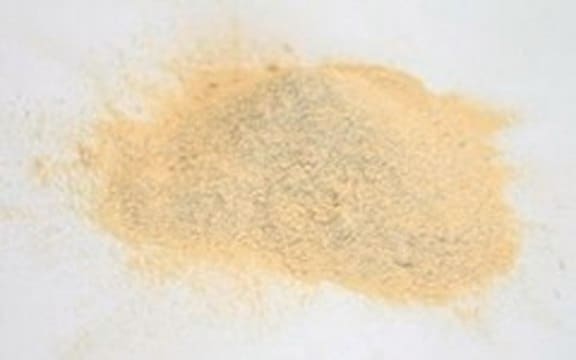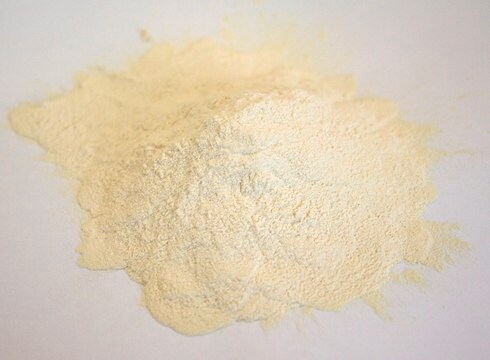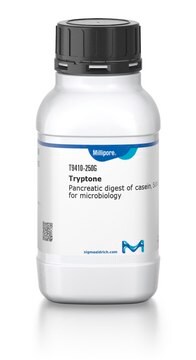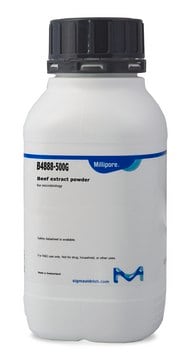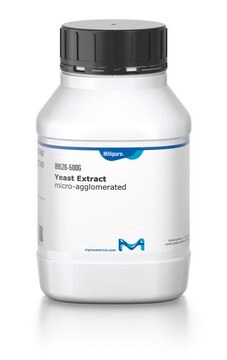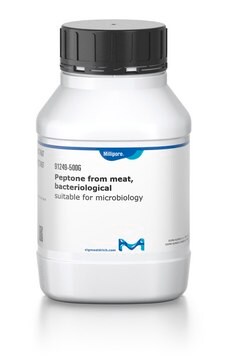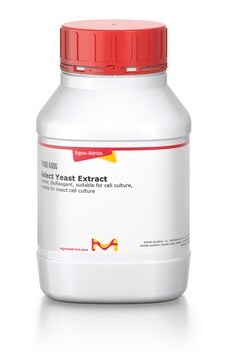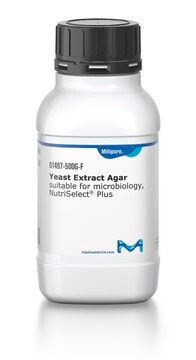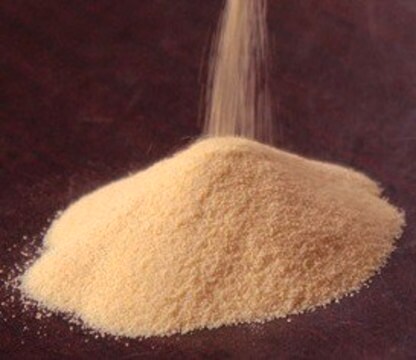All Photos(2)
About This Item
CAS Number:
EC Number:
MDL number:
UNSPSC Code:
41106212
eCl@ss:
42040000
NACRES:
NA.85
Recommended Products
biological source
Saccharomyces cerevisiae
Quality Level
sterility
non-sterile
form
powder
shelf life
limited shelf life, expiry date on the label
composition
amino-nitrogen, ≥4.5%
total nitrogen (N), ≥10%
packaging
pkg of 25 kg
pkg of 5 kg
pkg of 500 g
ign. residue
≤15%
loss
≤8% loss on drying
pH
6.5-7.5 (25 °C, 2% in H2O)
solubility
H2O: 2%, clear, light yellow to brownish-yellow
application(s)
food and beverages
microbiology
suitability
molds
yeasts
Looking for similar products? Visit Product Comparison Guide
Related Categories
General description
Yeast Extract Powder is manufactured from selected strains of Saccharomyces cerevisiae. It is recommended for use in microbial culture media, fermentation and other biological studies. Yeast extract is manufactured under controlled conditions to retain its vitamin content and other nutritive values such as peptides, free amino acids, nucleic acids, minerals, trace elements, and phosphorous compounds. It is rich in vitamins, especially the B complex, and is often used to supply these factors in culture media at a concentration of 0.3 - 0.5%.
Application
Yeast extract is particularly used in media for the cultivation of microorganisms encountered in milk or other dairy products and in the media for the detection and enrichment of pathogens and indicator organisms.
Storage Class Code
11 - Combustible Solids
WGK
WGK 1
Flash Point(F)
Not applicable
Flash Point(C)
Not applicable
Personal Protective Equipment
dust mask type N95 (US), Eyeshields, Gloves
Choose from one of the most recent versions:
Already Own This Product?
Find documentation for the products that you have recently purchased in the Document Library.
Customers Also Viewed
Alok Patel et al.
Marine drugs, 17(2) (2019-02-20)
Polyunsaturated fatty acids (PUFAs) are essential for human function, however they have to be provided through the diet. As their production from fish oil is environmentally unsustainable, there is demand for new sources of PUFAs. The aim of the present
Sara Hooshangi et al.
PLoS computational biology, 7(9), e1002172-e1002172 (2011-10-08)
Quorum sensing (QS) enables bacterial multicellularity and selective advantage for communicating populations. While genetic "switching" phenomena are a common feature, their mechanistic underpinnings have remained elusive. The interplay between circuit components and their regulation are intertwined and embedded. Observable phenotypes
Samriddha Ray et al.
The Journal of cell biology, 190(5), 793-805 (2010-09-02)
The mechanisms that regulate cytoskeletal remodeling during the transition between mitosis and interphase are poorly understood. In fission yeast the MOR pathway promotes actin polarization to cell tips in interphase, whereas the SIN signaling pathway drives actomyosin ring assembly and
Lisa M Røst et al.
Metabolites, 10(2) (2020-02-26)
Absolute quantification of intracellular metabolite pools is a prerequisite for modeling and in-depth biological interpretation of metabolomics data. It is the final step of an elaborate metabolomics workflow, with challenges associated with all steps-from sampling to quantifying the physicochemically diverse
Our team of scientists has experience in all areas of research including Life Science, Material Science, Chemical Synthesis, Chromatography, Analytical and many others.
Contact Technical Service

